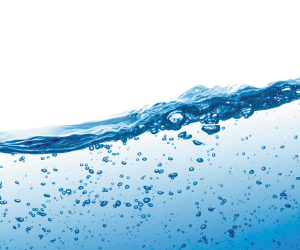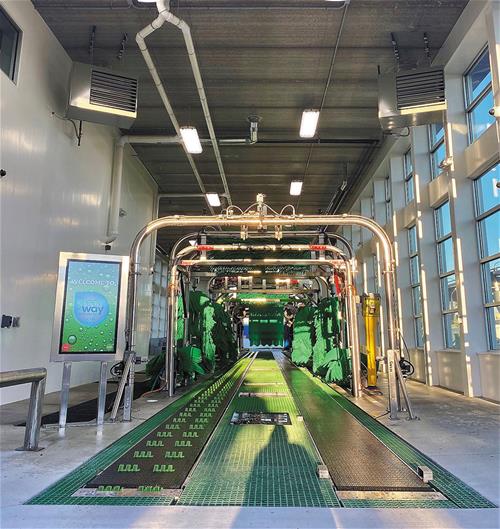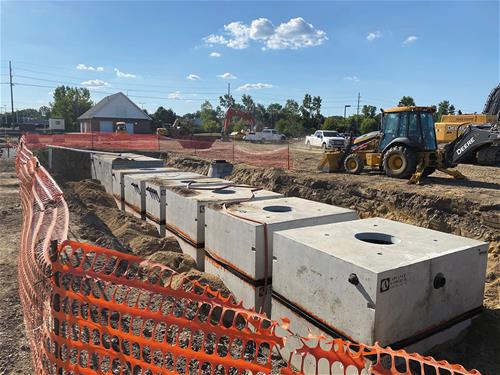
Sip, Sip, Sipping Away
April 14, 2022
12 minute ReadBy DAVID COBURN
Express Wash Concepts founder and CEO John Roush likes to say he’s “way more lucky than I am smart” and claims he didn’t have a grand plan in mind when he decided to install a full water reclamation system at his first Moo Moo Express location in the Columbus, Ohio, area in 2008.
But Roush’s success in building a model of water-sipping efficiency suggests that what might have begun as serendipity has evolved into sound strategy. Now 43 locations strong and operating in five states under the Moo Moo’s Express and four other brand names, Express Wash Concepts averages an impressively low 20 gallons of fresh water per vehicle (gpv), with many locations in the 17-18 gpv range.
Like many industry operators, Roush has discovered over the years that a commitment to saving, reclaiming and re-using one of our most precious natural resources has become a foundational piece of key business strategies — financial, marketing, corporate social responsibility, employee recruiting and retention, and even government relations.
“The money we’ve spent in the direction we’ve gone has probably saved the company hundreds and hundreds of thousands in costs but, also, our brand is synonymous with using a very low amount of water, so we’re strategically aligned with a growing number of our customers who care about the environment,” Roush said. “It’s probably even helped us grow, because we had extra capital for growth instead of giving it to cities in a water bill.”
 SQUEEZING OUT THE H2O
SQUEEZING OUT THE H2O
Like all of the operators interviewed for this story, Express Wash Concepts is an active member of WaterSavers, the International Car Wash Association (ICA) program that fosters water usage best practices and helps members market their proficiency in reducing water use to customers, municipalities and other important stakeholders. Members are required to use less than 40 gallons of fresh water per average wash.
That benchmark is below the industry average of 44.8 gallons of fresh water used at in-bay automatic washes and a little above the average for conveyor-type washes, according to a 2018 water use study commissioned by the ICA, so it’s an accessible target even for operators that use a combination of systems. In fact, most WaterSavers members report fresh water use significantly under 40 gallons, with many averaging less than half that amount.
The stingiest operators have cut fresh-water consumption down to the teens with state-of-the-art reclamation systems that use a series of underground settling tanks — some including naturally occurring bacteria that “eat” hydrocarbons and surfactants in the wash water — to produce clear, clean water for reuse. They also maximize their reuse of the so-called “reject water” left over from the reverse osmosis (RO) process used to produce spot-free water for the final rinse.
— Richard Enning”
Operators with the lowest numbers also pay close attention to an array of other water-saving strategies, including timely replacement and right-sizing of nozzles, proper timing and sequencing of water use throughout the wash cycle, and regular maintenance of the reclaim system. Integrating a vigilant approach to water management into team culture is also critical.
Charlotte-based Autobell has installed biological reclamation systems in 25 of its newer car washes opened over the past 15 years and reuses water in all 84 of its locations, said President and COO Carl Howard. These newer locations average about 12-22 gallons of fresh water per vehicle, while those washes using other reclamation systems use about 25. At its location on the edge of Charlotte’s tiny SouthPark neighborhood, even the gurgling fountain out front — an architectural grace note requested by neighbors when the property was rezoned for a car wash — circulates reclaimed water.
Even operators using the lowest-tech reclamation systems are beating their WaterSavers targets by a country mile. Essen, Germany-based Mr. Wash Autoservice AG, which uses a sand filter system to clean used water at its 35 conveyor-type car washes, reports fresh water use of about 30 gallons and 70 gallons of reclaimed water per wash, said Richard
Enning, CEO of Mr. Wash and a former ICA president. Mr. Wash also uses reject water from its RO system to flush the filters every 500-600 cars.
Enning would love to get his fresh-water use down — without sacrificing the quality of the wash, of course.
“It’s a very clear thing, if you want to do something, and you want to create a result — and our result is a clean car — you should try to get this result with as little resources as possible,” Enning said. “If you have the chance to wash the car really good with 20 gallons or with 30 gallons, you should rather wash it at 20 gallons.”
CRITICAL TO BOTTOM-LINE SUCCESS
Of all the ways car wash operators are incorporating water usage into business decisions, the most obvious and universal is as a financial strategy. It’s about cutting costs to enhance the bottom line, pure and simple.
Rising water and sewer rates and hefty impact fees for new car washes to tap into public water and sewer systems are pushing more operators in many parts of the country to recalculate the costs and benefits of investing in reclamation and reuse. And there appears to be no end in sight to the inexorable upward trend in the cost of water.
“After chemistry, water usage is probably your largest cost,” said Brent Wigginton, Co-owner and President of Operations at Michigan-based GreenWay Auto Wash, which has two locations in the Detroit metro area with plans to add up to 10 more. “I’ve talked to friends in the business around the country who are spending $25,000 a quarter on just water and sewer, and they have no reclaim system or anything. There really is a financial benefit if you want to do it the right way.”
Both GreenWay locations, opened in the past year, average a miserly 14 gallons of fresh water per wash using biological reclamation systems. The company’s first location in Utica, Mich., north of Detroit, saved an estimated 2 million gallons of fresh water in its first nine months of operation, resulting in an estimated addition to the bottom line of $32,000 in cost savings from avoided water and sewer charges, Wigginton said.
“Water’s just expensive, so we do everything we can to keep it under control,” said Brad Levie, who operates four WashHounds sites in New Jersey with fresh-water use running from 18-25 gpv. “Obviously, the less fresh water you use the less they’re going to charge you for sewer, so again it gets back to simple profit/loss analysis. Best practices for the environment are also best practices for your bottom line.”
The role of rising water and sewer costs in driving decisions to invest in reclamation and reuse is clear enough. Conversely, in parts of the country like Louisiana, where water and sewer rates are a fraction of those charged elsewhere, the case for recycling isn’t as compelling because there’s less of a pressing financial need to save more water.
LEVERAGING THE ECO-FRIENDLY MESSAGE
Consumer studies by the ICA have shown that concern for the environment typically isn’t a deciding factor in getting a customer to a certain car wash on the first visit — although 55% of consumers do perceive getting their car washed professionally is more environmentally friendly than washing a car at home.
But as part of a marketing strategy, being able to tell a good story about your water use practices can help woo more environmentally conscious customers and build customer loyalty, operators agree.
“Using the fact that you’re an eco-friendly site as a differentiator — all other things being generally the same — might be the tie-breaker,” said GreenWay’s Wigginton. “The majority of professional car wash customers are female, and our research showed that women tend to be a little more in tune with that kind of thing, and we believe that influences their purchasing behavior. They’re more likely going to choose the guy that’s reclaiming than the guy that’s not.”
— John Roush, Express Wash Concepts”
GreenWay is all-in on going green. Its website trumpets the aspiration to be “Detroit’s (and the Earth’s!) favorite car wash” and the ICA’s WaterSavers logo is displayed on every page. Water reclamation and reuse is just one aspect of its environmental stewardship, which also includes a comprehensive recycling program, collecting rainwater in a 1,000-gallon cistern to irrigate landscaping and a partnership with the local Clinton River Watershed Council. Wigginton joins in on the council’s river clean-up projects and GreenWay donates a nickel to the group from every wash.
“Putting in full reclaim systems on our washes saved us a lot of money but also was a pretty good story for our consumers,” said Express Wash Concepts’ Roush, whose car washes feature posters touting the water savings to every customer. “It’s pretty cool to be able to tell people we use only 20 gallons (of fresh water) per wash compared to 120 in your driveway or a gas station or an in-bay automatic. That’s a tipping point for our customers to say, ‘Hey, we’d rather use that company than waste a lot of water in my driveway.’”
WashHounds’ Levie thinks many operators, including himself, can be doing more to leverage their stingy water use as a marketing tool.
“I think our customers very much care about conservation, the environment and global warming and we need to do a better job of teaching about what we and they, as customers, can do to help with the problem,” said Levie. “I don’t think we do enough to educate them on the benefits and the WaterSavers program is part of that educating process. With the help of WaterSavers, we are planning more social media and site signage to help them understand how we can help.”
Brett Schaechter, Owner of Whip Clean Car Wash in Bowie, Md., which has one location averaging in the “high 20s” on fresh-water use per wash, said his own experience talking to folks in his community doesn’t quite sync up with the survey numbers that show most consumers rank commercial washes as more eco-friendly than the DIY driveway wash.
“It’s just an old story, perception sometimes is reality; People think you’re doing so much of it that you have to be doing more harm to the environment than they are washing their car in their driveway,” Schaechter said. “I think it’s something we need to continue to talk about and share that knowledge with our consumers.”
Levie agrees: “The bigger picture is washing your car at a professional tunnel like this is much more environmentally friendly than washing your car at home. That’s the bigger message.”
 ROLE IN EMPLOYEE RECRUITING AND RETENTION?
ROLE IN EMPLOYEE RECRUITING AND RETENTION?
Some wash operators that have made a serious commitment to being a WaterSaver believe there’s an additional payoff: an enhanced ability to attract and retain employees.
“It’s about the whole culture here, not just the environmental thing, but for some people when they see (the commitment to saving water) they get a little excited about that,” said GreenWay’s Wigginton. “They’d like to be part of an organization that’s not just taking, that’s a part of their community that gives back in some meaningful way and is a responsible custodian of our natural resources.”
As a tool for recruiting new employees, Autobell’s Carl Howard views the company’s frugal use of water and its broader environmental stewardship as a positive but probably not the deciding factor for most individuals who accept a job offer from the company.
“I don’t believe environmental policies push a younger person to work with us versus another job opportunity, but it’s an important principle and part of our values as well as good stewardship. We talk about it with all our team members, not just the young people that we’re hiring,” Howard said. “People want to know they work for a company that is making an impact to protect the environment and that they are a part of this kind of purposeful initiative. Our industry on the whole is a big part of both conserving water and also disposing of that water in a proper way as opposed to driveway car washes or a wash that allows runoff to go into the storm drain.”
EDUCATING INFLUENCERS TO FUTURE-PROOF THE INDUSTRY
Industry leaders in water-saving measures including reclamation and reuse also see today’s responsible stewardship as the ultimate survival strategy. Doing the right thing now will help future-proof the car wash industry against a growing alliance of forces aligned against it as drought, climate change and population growth continue to pressure the planet’s precious water supply.
It’s Government Relations 101: Educate the policymakers and arm them with the facts so they’ll make policy decisions based on solid information and rational arguments, not the last, loudest voice they hear screaming in their ear.
— Brad Levie, WashHounds”
In water-rich Germany, use of the resource is only beginning to emerge as an issue for wash operators, said Mr. Wash’s Enning. Still, he can foresee a time when he’s including water-saving stats on customer receipts just as he does now with information about his use of solar energy and other efforts to reduce Mr. Wash’s carbon footprint.
Mr. Wash already touts its water efficiency performance in brochures — replete with the WaterSavers logo — that it uses to educate local officials in municipalities where new locations are up for approval.
“It shows them that we are really working on this issue,” Enning said. “It’s not a big problem now, but it might become a bigger problem. We all know that in California and across the western U.S. it wasn’t a problem 20 years ago and today it’s a big problem in these areas. Things are changing, nothing is stable, and maybe in 10 years or so we might also have a situation in Germany or in Europe where we have water issues.”
WashHounds’ Levie has taken a similar approach to government relations — even going as far as bringing mayors and local state senators in for “back-of-the-house” tours to educate them not only on WashHounds’ responsible water usage but also its contribution to the local economy through job creation and tax revenues.
“We’ve certainly spent time with our local governments trying to explain the story of why you want professional car washing instead of DIY. You don’t want that water running off into the gutter, you want it running into the sewer, and it’s not just the water, it’s the chemicals,” Levie said. “It’s a bit of a preventative measure on our part. We want to make sure that if we’re in a drought situation, (local officials) should be shutting down the washing the car in your driveway, not the professional car washes.”
LEVERAGING THE STRATEGIC VALUE
Express Wash Concepts’ Roush insists his initial decision to invest in reclamation wasn’t part of a full-blown business plan worthy of a Harvard Business School case study. It was more like “Yeah, that sounds like a good idea, let’s do that.”
But he understood the potential soon enough, and water reclamation and reuse is now a cornerstone of the company’s business strategy on several fronts.
Said Roush: “After the dust settles and you think about what you’re doing and how you can spin off of decisions to make it marketable and kind of work it in all directions, then you can really start to leverage the strategic value.”
WaterSavers® is a recognition program from the International Carwash Association designed to help professional car washes promote their environmentally responsible business practices. It is open to all car washes meeting program criteria. For more information, visit www.carwash.org/join-watersavers. To access the water study, Water Use, Evaporation and Carryout in Professional Car Washes, visit www.carwash.org/resources








